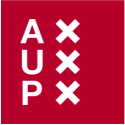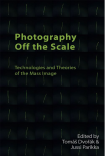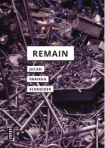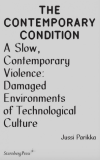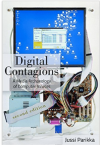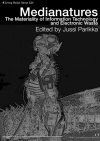Archive
Queuing
This is a chapter from a couple of years back but reading something today on queuing (as ordering, waiting, allocating, as Celia Lury puts it in her wonderful new book Problem Spaces) made me return to it and also post here. The chapter on “Underpinning Time” focuses on questions of microtemporality that creates publics or collectives as being modulated through cultural techniques of of temporality in networks. While the chapter is far from a full-fledged take on queuing, of standing in line and waiting for ones turn, it starts with the core scene that defines also a certain moment of network time/allocation of packets in traffic.
“The Underpinning Time” came out in the collection Digital Memory Studies edited by Andrew Hoskins.
In Search of Media: Remain
I am excited to announce that our co-authored booklet Remain is now out and available via University of Minnesota Press and Meson Press (Open Access PDF). Together with Rebecca Schneider, and Ioana Jucan who wrote the introduction, we were offered the term “remain” to respond to as part of the series of investigations as to “terms of media” in contemporary context. From the book’s description and with two blurbs from Joanna Zylinska and Steven Shaviro:
In a world undergoing constant media-driven change, the infrastructures, materialities, and temporalities of remains have become urgent. This book engages with the remains and remainders of media cultures through the lens both of theater and performance studies and of media archaeology. By taking “remain” as a verb, noun, state, and process of becoming, the authors explore the epistemological, social, and political implications.

“What emerges in this short book is a theory of media as that which remains. Mediating deep time with temporarily fossilized moments in our cultural history, the book’s multivoice narrative raises important questions about human responsibility for matter and other matters.”
— Joanna Zylinska, Goldsmiths, University of London
“This book spells out the ways in which past media and past practices continue to haunt and inflect our present social and technical arrangements.”
— Steven Shaviro, Wayne State University
For paperback, see University of Minnesota Press page.
For Open Access, see Meson Press page.
The Residual Media Depot summer school
I had the pleasure of being one of the participants in the Media Archaeology summer school in Montreal at the Residual Media Depot (Concordia). Invited by Darren Wershler, and teaching alongside also Lori Emerson, we had a wonderful group of participants from Canada, Finland, USA, UK and Spain whose own projects and their work at the Depot during the week demonstrated a fantastically broad spectrum of what media archaeology can perform.

I could not emphasise the word perform enough: while we engaged with the theoretical limits and limitations of theoretical work in and around media archaeology, including how it interfaces with for example infrastructure studies, the various probes the students presented and the hands-on work in the Depot investigated the idea of collections as part of the methodology. The performative aspect of media archaeology – and theory broadly speaking – allows to both see it as a situated practice that benefits from its access to institutions and collections as well as creates the space for such to exist: to imagine a media archaeology lab or a collection becomes also a projective way of engaging with the current themes of reshifting humanities infrastructure and institutional changes. As Wershler and Lori Emerson, the director of the Media Archaeology Lab at Boulder, Colorado, also underlined, it is through the particular materiality and access to collections that one can think differently in relation to what are often deemed objects of (media) cultural heritage.

Relating the course’s themes to also his own research, Wershler explained how his interest in the cultural life of signals builds on work in the Depot too. To engage in the work of assembly through old but still functioning systems one is led to understand the various ways the life of signals is constantly constructed and re-constructed across multiple fields of agency from hobbyists to the mini-industry building the various technological tools for an afterlife of for example consoles.
Media archaeology embodies multiple temporalities. The different theoretical frameworks from Erkki Huhtamo to Siegfried Zielinski to Wolfgang Ernst are different solutions to the problem of time – how to approach time differently in methodological ways and in ways that understand technical temporality. For example, Ernst’s ways of approaching time criticality and temporal operationality are something that both offer a different ontological take on technology and also can act as interesting guides in how we work with collections such as the Depot.
In my view, the Residual Media Depot was a perfect platform for the workshop. Wershler had designed the week as a mix of theoretical investigations, student probes and practice-based work that functioned somewhere between maker methodologies, art practices and an archival interest in collections that are important for media theory too. The collection is focused on cultures and technologies of gaming with a special focus on consoles, but as Wershler emphasises, it is not a game archaeology depot. The consoles and the material around them is an entry point to media history and signal culture.

In several ways, the Depot’s work aligns nicely with the Media Archaeology Lab but also with our AMT group: to establish a framework and an enabling situation for a research-teaching continuum that is interested as much in practice-based work as it is in explicating what practices of theory are. All of this feeds also as part of the Lab Book we are writing together.
You can find more information about the Depot on their website and on the same site you can find all the student probes from our week of Media Archaeology.
The Residual Media Depot (RMD) is a project of the Media History Research Centre in the Milieux Institute at Concordia University.

“More things in Theory…”: An Interview with GWY
A lovely new interview with Geoffrey Winthrop-Young has been posted online: “More things in theory than heaven and earth are dreaming of.” Conducted by Melle Kromhout and Peter McMurray, it brings out great points. Winthrop-Young is always a pleasure to read, both because of the tone and the insights. Of course, in this case I remain biased, with the focus of the interview being about the so-called German media theory (which is not, as we are reminded, not so German, not pretending to present a big theory nor is it really merely German), Bernhard Siegert, cultural techniques and by the end, also about “media biology”. What’s not to like.
GWY has a fantastic sense of explication when it comes to media theory. When he responds about the subject topic of the interview that “cultural techniques are further installation of modern theory’s crusade against the as such” it both gives a subtle sense of how it maps as part of the contemporary theory landscape (and the persisting enthusiasm for the ontological as suchs) and also reminds me why I feel attracted to cultural techniques and related media analytical directions; I am, after all, a slowly recovering (cultural) historian who does not mind that the notions we operate by, the cultural layers, “all the levels all the way down are made up of historically locatable practices” even if with various twists of complex feedback loops.
Recursions: a new book series in media & cultural theory
 We are proud to announce the launch of a new book series titled Recursions: Theories of Media, Materiality and Cultural Techniques. Placed with Amsterdam University Press, a publisher known for its strong track-record in film and media studies, the series will publish fresh, exciting and important books in media theory. This includes both translations and other volumes that address the core themes outlined below. I am very excited about this project and working with my co-editors Anna Tuschling and Geoffrey Winthrop-Young. We have already some significant projects lined up for 2015 and more forthcoming that we will announce in the coming weeks and months. We are supported by a very strong international advisory board. Get in touch if you want to learn more but first read below for more information!
We are proud to announce the launch of a new book series titled Recursions: Theories of Media, Materiality and Cultural Techniques. Placed with Amsterdam University Press, a publisher known for its strong track-record in film and media studies, the series will publish fresh, exciting and important books in media theory. This includes both translations and other volumes that address the core themes outlined below. I am very excited about this project and working with my co-editors Anna Tuschling and Geoffrey Winthrop-Young. We have already some significant projects lined up for 2015 and more forthcoming that we will announce in the coming weeks and months. We are supported by a very strong international advisory board. Get in touch if you want to learn more but first read below for more information!
New Series Announcement
The new book series Recursions: Theories of Media, Materiality, and Cultural Techniques provides a platform for cutting- edge research in the field of media culture studies with a particular focus on the cultural impact of media technology and the materialities of communication. The series aims to be an internationally significant and exciting opening into emerging ideas in media theory ranging from media materialism and hardware-oriented studies to ecology, the post-human, the study of cultural techniques, and recent contributions to media archaeology.
The series revolves around key themes:
- The material underpinning of media theory
- New advances in media archaeology and media philosophy
- Studies in cultural techniques
These themes resonate with some of the most interesting debates in international media studies, where non-representational thought, the technicity of knowledge formations and new materialities expressed through biological and technological developments are changing the vocabularies of cultural theory. The series is also interested in the mediatic conditions of such theoretical ideas and developing them as media theory.
Forthcoming 2015
- Sybille Krämer – Medium, Messenger, Transmission: An Approach to Media Philosophy.
- Claus Pias – Computer Game Worlds.
Editorial Board
- Jussi Parikka (University of Southampton)
- Anna Tuschling (Ruhr-Universität Bochum)
- Geoffrey Winthrop-Young (University of British Columbia)
Advisory Board:
- Wendy Hui Kyong Chun (Brown University, US)
- Geert Lovink (Hogeschool van Amsterdam, The Netherlands)
- John Durham Peters (University of Iowa, US)
- Thomas Y. Levin (Princeton University, US)
- Marie-Luise Angerer (University of Arts Cologne, Germany)
- Eva Horn (University of Vienna, Austria)
- Markus Krajewski (University of Basel, Switzerland)
- Erick Felinto (State University of Rio de Janeiro, Brazil)
- Adalberto Müller (Federal University of Niterói, UFF, Rio de Janeiro)
- Eivind Røssaak (National Library of Norway)
- Steven Connor (Cambridge University, UK)
- Peter Krapp (UC Irvine, US)
- Antje Pfannkuchen (Dickinson College, PA, US)
- John Armitage (Winchester School of Art, UK)
- Till Heilmann (University of Siegen, Germany)
- Isabell Otto (University of Konstanz, Germany)
- Astrid Deuber-Mankowsky (University of Bochum, Germany)
- Sean Cubitt (Goldsmiths College, London, UK)
- Claus Pias (Leuphana University, Germany)
- Stefan Rieger (University of Bochum, Germany)
- Andrew Murphie (University of New South Wales, Sydney, Australia)
- Axel Fliethmann (Monash University, Melbourne, Australia)
- Yuji Nawata (Chuo University, Tokyo, Japan)
Authors’ information
Proposals welcomed
Proposals for monographs or edited volumes should kindly follow the standard AUP Proposal Form (http://en.aup.nl/en/service/authors) and should also include the envisaged table of contents, an overview of the volume and abstracts of the proposed chapters or articles.
Further information
If you are interested in publishing a book with us please contact Jeroen Sondervan, Senior Commissioning Editor for Film & Media Studies at j.sondervan@aup.nl or one of the series editors.
More information about Amsterdam University Press.
Archaeology
Siegfried Zielinski asked me to write a very short dictionary type of entry on “Archaeology” for an exhibition catalogue. The exhibition will take place at Edith Russ Haus for Media Art in 2014 and they are going to do an exhibition on Zielinski’s AnArchaeologies and Variantologies, including some artistic positions by David Larcher, Herwig Weiser, Anthony Moore and others. Below my contribution.
Archaeology
The 19th century disciplinary invention of “archaeology” has had major impact in and out of academia. Besides the specific methods for investigating the material remains of human cultures, of building on the fragments to create collections, narratives and modes of preservation for a varia of objects and documents, the archaeological imaginary penetrates our audiovisual culture. It persists as an imaginary of itself: the narratives and images of hidden treasures waiting to be ungrounded. And it persists as the conceptual legacy that comes not only from archaeology proper, but also from Immanuel Kant.
Kant’s idea of philosophical archaeology itself ungrounded the idea of conceptual work building on the ruins of earlier philosophers. As Giorgio Agamben argues, this lead to the more fundamental notion of arkhé that refers not to origins, but to command and commencement. In a way that resonates with the media archaeologist Wolfgang Ernst’s understanding of the “arche” in (media) archaeology, this archaic moment is less the historical than the conditioning beginning of any analytical and genealogical investigation. For Agamben “[a]rchaeology is, in this sense, a science of ruins, a ‘ruinology’ whose object, without constituting a transcendental principle properly speaking, cannot really claim to be there as an empirically given totality.”
Such an understanding shifts from archaeology proper to the archaeology of knowledge in Michel Foucault’s sense. It displaces archaeology restricted to material excavations and works it into a method of archival and philosophical conditions of knowledge – its objects, statements and assumptions. With media archaeology as practiced by a variety of scholars from Siegfried Zielinski to Erkki Huhtamo, Thomas Elsaesser to Wolfgang Ernst, and even with Friedrich Kittler’s earlier writings, the material returns at the centre of the archaeological dig. It has many different meanings and ways of adopting to the object of investigation but it insists on irreducibility to the textual.
Indeed, what in archaeology are the methods necessary to approach the time before writing and the document pertains for media archaeologists both to the pre-cinematic as a similar rhetorical field of investigation and to the ontologically important idea of the arche as a command – even a technological command as the starting point for ungrounding media cultural ruins still present.
Speculative Scenarios for Digital Art
There is a new book on digital art, archives, preservation and memory out now. Edited by Annet Dekker, Speculative Scenarios, or what will happen to digital art in the (near) future? is an interesting and again timely take on some of the issues that connect media studies with archival specialists, cultural heritage with contemporary digital art practices. There are several great writers in the collection. You can find it online here and a printed version is out soonish too.
On the publisher website, the book is described as follows:
“There is a growing understanding of the use of technological tools for dissemination or mediation in the museum, but artistic experiences that are facilitated by new technologies are less familiar. Whereas the artworks’ presentation equipment becomes obsolete and software updates change settings and data feeds that are used in artworks, the language and theory relating to these works is still being formulated. To better produce, present and preserve digital works, an understanding of their history and the material is required to undertake any in-depth inquiry into the subject. In an attempt to fill some gaps the authors in this publication discuss digital aesthetics, the notion of the archive and the function of social memory. These essays and interviews are punctuated by three future scenarios in which the authors speculate on the role and function of digital arts, artists and art organisations.”
I was interviewed for the book and I talked about topics from zombie media to media archaeology & time, from the media archaeological fundus in Berlin to issues of the social. “In a way, practices – or one could say cultural techniques – of memory are actually what create the social. Perhaps the social doesn’t even exist without the various ways in which memory is sustained, articulated, archived, controlled, passed on, distributed, received, and remixed.”
Ernst on Time-Critical Media: A mini-interview
One of my interests of the recent times has been “microtemporality”. This interest has been spurred both by Wolfgang Ernst’s media archaeological theory and publications such as Axel Volmar’s 2009 edited volume on time-critical media. Indeed, notions of microtemporality offer ways to understand the technical conditioning of social/cultural processes on a level that is irreducible to the phenomenological. With different emphases to those of Ernst’s I know that for instance Katherine Hayles is nowadays looking at algorithmic trading from the temporal perspective too and Mark Hansen is from a more Whitehead perspective investigating ubiquitous media environments and that what escapes conscious cognition. See also Shintaro Miyazaki on these topics through the concept of Algorhythmics in Computational Culture.
In the midst of my own research into different temporalities that media archaeology offers, as well as network times/politics, I wanted to conduct a mini-interview with Wolfgang Ernst. Hence, please find below Wolfgang Ernst, responding to my question “what is time-critical media and microtemporality?”
Wolfgang Ernst:
“Technological media have a distinct quality: They are in their medium-being only in operation (“under current”). This specificity makes them especially sensitive to micro-temporal intrusion, irritation and manipulation – much more than previous cultural techniques like alphabetic writing which became time-critical only when electrically coded into telegraphy.
It was Gotthold Ephraim Lessing who in his treatise on the comparative aesthetics of poetry and visual arts Laokoon in 1766 identified what the called the “pregnant moment” in the representation of action. In electronic television the exact synchronisation, thus timing, of signals becomes crucial for the human aisthesis of image perception indeed. With techno-mathematical computing where minimal temporal moments become critical for the success of the whole process of internal calculation and human-machine communication (“interrupt”), time-criticality becomes a new object of epistemological attention in the economy of knowledge. When culture is rather counted than narrated, time-criticality needs to be focussed by process-oriented (thus dynamic) media archaeology.
Time-criticality in its media-technological context does not refer to a philosophical or critique of contemporary politics or ethics but rather to a special class of events where exact timing and the temporal momentum is “decisive” for the processes to take place and succeed at all. In its ancient Greek sense, crisis refers to the chances of decision, with its temporal form being an impulse rather than a duration or narrative – kairotic time. Kairos – the ancient Greek god of the decisive moment – becomes proverbial in post-modern just-in-time production in both industry and technologies, as well as in deadly situations like antiaircraft prediction in Second World War.
In its etymological roots, “time” itself refers to divisions of continuity, to the cutting edge. Apart from its long aesthetic tradition, the cultural impact of time-criticality escalates with (and within) technological media, starting from photographic exposure time which almost shrank towards zero. Signals which are operated with electronic speed can hardly be followed by human consciousness like, for example, symbols (printed letters) in textual reading. When signal transfer happens below human sensation, it can be spotted only by time-critical observation. For subliminal events the true archaeologist of time-critical knowledge are technical media themselves; only with the emergence of hightly sensitive measuring instruments since the 19th century time-critical processes like the runtime of signals within human nerves became analyzable at all.”
A Fundus for Media Theory
Lori Emerson has interviewed Wolfgang Ernst for the Library of Congress blog. It is a great conversation that also addresses the differences between digital preservation and Ernst’s Media Archaeological approach. The latter is, as mentioned on this blog as well, placed and spatialised in the Media Archaeological Fundus (Fundus= bottom, ground), part of his Media Studies Institute. (This idea worked even better at the original Sophienstrasse 22 address of the Institute, because it was located deep in the concrete bunker type basement).
Ernst emphasises the connection between teaching media theory and practicing material “hermeneutics”: to have access to technological devices, opening them up, reverse engineering. Operationality is at the centre of this view concerning media studies. A dysfunctional television is just a design object: media starts when it can operate signals. Ernst’s approach draws from a Heideggerian pun (of sorts) of the objects of the Fundus as Epistemological Spielzeug (ref. to Heidegger’s Zeug), “epistemological toys” for pedagogical purposes.
Ernst responds to one of Lori Emerson’s questions:
“The bias of MAF based teaching is to train students to resist the nostalgic or even melancholic impulse which is normally associated with so-called “dead media”, and to discover the retro-futuristic element instead. The electric telegraph, e. g., operates with discrete signal transmission: a code which after an age of AM media (such as radio) returned in unexpected ways. Whereas digital data transmission is much too fast to be perceivable directly to human senses, the classic telegraph “dots and dashes,” when connected to an acoustic mechanism, may serve as a way of slowing down and sonifying the nature of coded signal transmission.”
Such a focus on spatialities of media studies emphasises more points concerning the current interest in thinking about “theory as practice”: the various techniques, institutions and spatialities in which cultural/media theory takes place. For instance the Fundus is a sort of a ground(ing) as well as underbelly of media theory, in how the technical and tactile engagment with technologies enables a connection to text and theory. Ernst is very reluctant to call this “Digital Humanities”: it’s media studies!
Read the full interview here.

We had in Berlin just last week our joint book launch with Ernst: his Digital Memory and the Archive alongside my What is Media Archaeology? It was great to be launching the theory books in the midst of yet another great bunch of transmediale exhibitions of media archaeological resonance: the Octo Pneumatic Media System (a Rohrpost in action), the Evil Media Distribution Centre, Refunct Media vol. 5, and more.
Berlin, BWPWAP, and Book Launch
Transmediale starts today with its puzzling, great theme Back When Pluto Was a Planet (BWPWAP). Except conceptual, temporal and spatial shifts and displacings of various sorts. This is the first year our Winchester School of Art also is collaborating with transmediale, and as part of that we are hosting a panel on military  technologies, space and Cold War.
technologies, space and Cold War.
In addition, I am sharing a book launch with Wolfgang Ernst: It is the book I edited of his writings alongside my own What is Media Archaeology? Join us for that on Friday, 1st of February.
And as a Kittlerian cherry on top, on Saturday evening I am participating in the performance Sources, Synths, Circuits that focuses on the reconstruction of the late Prof Kittler’s synthetizer. We discuss that from the perspective of not only Kittler, music, technology but also archives.
